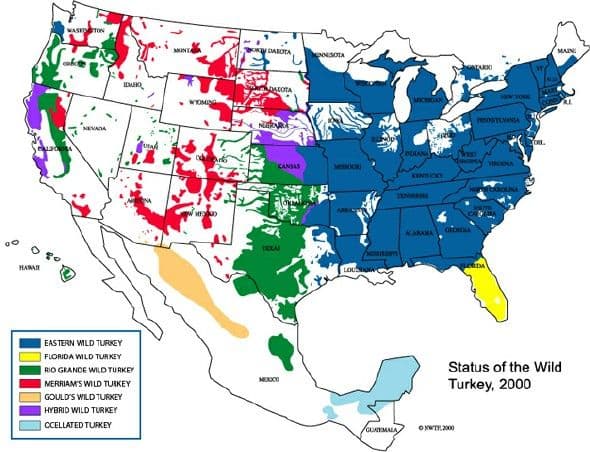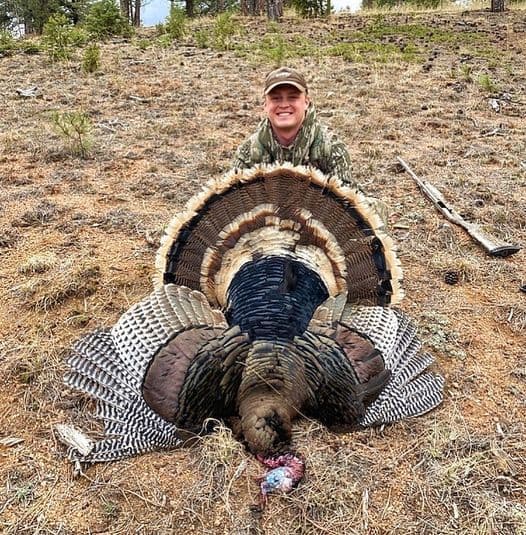Turkey Hunt Nebraska


Michael Maroney
02/20/2023
From the Sandhills to the eastern creek bottoms and cottonwoods of the North Platte, the state of Nebraska can be one of the best places in the country to chase spring turkeys. Meriam, hybrids and the occasional eastern turkey can be found in different regions across the state giving you a chance to complete up to 3/4 of the grand slam in Nebraska alone. To sweeten the deal, Nebraska sells over-the-counter tags for the entire state. Here are a few tips and tricks to help you be successful on your Nebraska Turkey hunt.
Season Dates: Nebraska turkey season runs from March 25th to May 31st with the inclusion of archery and youth seasons. Archery season begins on March 25th and runs for the entirety of the season. Youth hunters can begin hunting with shotguns on April 8th, one week prior to everyone else. Regular shotgun season begins on April 15th and runs through the end of May. Crossbows and regular compound or trad bows are all legal in the state of Nebraska for turkey season.
How to Get a tag: Starting in 2023 the Nebraska Game and Parks has limited the number of non-residents over the counter tags to 10,000 for the spring season. With just under 2 months left before the season starts, tags left available are down to approximately 3000. Most of those sales came in the first 2 weeks of them being available, however we expect to see the remainder sell out by mid-April. Resident tags are unlimited and can be purchased over the counter for all units. Tags can be purchased online at the Nebraska Game and Parks website. Tag prices range from $8 for youth, $30 for residents, and $128 for non-residents. Unlike other states such as Kansas and Colorado, Nebraska does not require a small game license to hunt turkeys.

Where to hunt: Nebraska is fortunate enough to have large numbers of turkeys across the state depending on what type of turkey you want to chase. The Black Hills, in the northwestern part of the state, is home to a great number of Meriam’s. These turkeys can be found living in ponderosa forests and creek bottoms close to water and food sources. As spring approaches, find Meriam’s following the snow line into the denser ponderosas where they look to breed. As you move east across the state you run into a diverse selection of habitat, ranging from creek bottoms, small canyons and pastures, to agriculture fields. As you move across the state, you will find a variety of birds including hybrid, Rio Grande/Meriam’s. These birds tend to frequent large roost trees near water and food sources and move in and out of agriculture fields during the daytime. The eastern part of the state has a population of eastern turkeys that have migrated into the creek bottoms and wooded regions near the border. These offer a great opportunity to chase big callable birds within the state.
Set ups and hunt tactics: All species of turkeys in Nebraska follow the same habitual tendencies during the spring. Hens and toms/jakes are looking to breed during the warmer spring days and are driven to group up or socialize depending on how far along they are in the breeding season. In general, look for toms to begin the season in larger groups with their hens. As the breeding season progresses, they break off into smaller bachelor groups while competing for hens. Hens will likely stick together until they become bred and begin to nest later in the season.
Turkeys will usually visit the same roost tree or group of roost trees each night if unbothered throughout the season. With that in mind, setting up within calling distance but not directly underneath the roost tree can be effective. Calling can be very useful throughout the season for both locating and bringing in toms/jakes, especially as the season progresses and hens become less available. Both louder box calls and slate calls will carry longer distances and get the attention of nearby birds. Diaphragm calls can be very useful for closing the gap with interested turkey due to their quieter pitch and the minimal movement required to use them.
While they can’t smell, turkeys have incredible eyesight and can spook at that slightest unfamiliar movements. Full camo, including face coverings are a necessity along with good cover behind you in your set up. Decoys, specifically those that can swap real turkey fans on them can be very effective in most situations.
Pro Tip: For Meriam’s and hybrids, try very slow spot and stalk techniques. Use a call to locate turkeys and try to intercept where they are going to feed or breed. Use a decoy or fan to break up your appearance and slowly move in on a target using the topography in your favor. Be ready to shoot as they won’t give you much time!

Best of luck to all the turkey hunters this season! Check out the Infinite Outdoors App to access thousands of acres of private land for your next DIY turkey hunt!